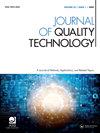Multi-sensor based landslide monitoring via transfer learning
IF 2.2
2区 工程技术
Q2 ENGINEERING, INDUSTRIAL
引用次数: 12
Abstract
Abstract Landslides are severe geographical activities that result in large quantities of rock and debris flowing down hill-slopes, leading to thousands of casualties and billions of dollars in infrastructure damage every year worldwide. For detecting landslides, on-site sensor systems are widely applied for data collection and many existing statistical process control methods can be adopted for modeling and monitoring. However, the conventional methods may perform poorly or even inapplicable when the sensors have different set-up times and end times, especially when the system includes newly deployed sensors with limited data collected. To make effective use of such new sensors immediately after deployment, we propose a novel multi-sensor based charting scheme for dynamic landslide modeling and monitoring by using transfer learning. A regularized parameter-based transfer learning approach integrated with the ordered LASSO is first proposed to effectively transfer information from old sensors with sufficient historical data to new ones with limited data. The approach considers the similarities not only between the autoregressive coefficients of different sensors, but also between the temporal correlation patterns. A control chart is then proposed for monitoring the newly deployed sensors sequentially based on the generalized likelihood ratio. Extensive simulation results and a real data example of landslide monitoring demonstrate the effectiveness of our proposed method.基于迁移学习的多传感器滑坡监测
滑坡是一种严重的地理活动,导致大量的岩石和碎屑从山坡上流下,每年在世界范围内造成成千上万的人员伤亡和数十亿美元的基础设施损失。在滑坡检测中,现场传感器系统被广泛应用于数据采集,现有的许多统计过程控制方法可用于建模和监测。然而,当传感器具有不同的设置时间和结束时间时,传统方法可能表现不佳甚至不适用,特别是当系统包含新部署的传感器且收集的数据有限时。为了在部署后立即有效地利用这些新传感器,我们提出了一种基于迁移学习的动态滑坡建模和监测的基于多传感器的新制图方案。首先提出了一种基于正则化参数的迁移学习方法,该方法与有序LASSO相结合,可以有效地将历史数据充足的旧传感器信息传递给数据有限的新传感器。该方法不仅考虑了不同传感器自回归系数之间的相似性,而且考虑了时间相关模式之间的相似性。然后提出了一种基于广义似然比的控制图,用于对新部署的传感器进行顺序监控。大量的仿真结果和一个实际的滑坡监测数据实例证明了本文方法的有效性。
本文章由计算机程序翻译,如有差异,请以英文原文为准。
求助全文
约1分钟内获得全文
求助全文
来源期刊

Journal of Quality Technology
管理科学-工程:工业
CiteScore
5.20
自引率
4.00%
发文量
23
审稿时长
>12 weeks
期刊介绍:
The objective of Journal of Quality Technology is to contribute to the technical advancement of the field of quality technology by publishing papers that emphasize the practical applicability of new techniques, instructive examples of the operation of existing techniques and results of historical researches. Expository, review, and tutorial papers are also acceptable if they are written in a style suitable for practicing engineers.
Sample our Mathematics & Statistics journals, sign in here to start your FREE access for 14 days
 求助内容:
求助内容: 应助结果提醒方式:
应助结果提醒方式:


